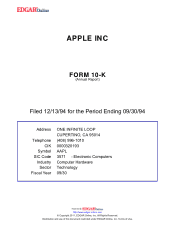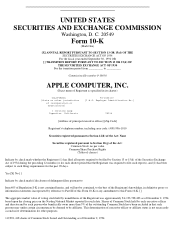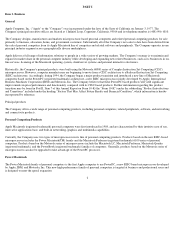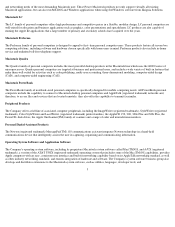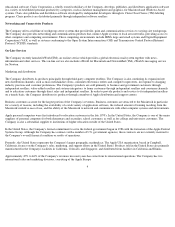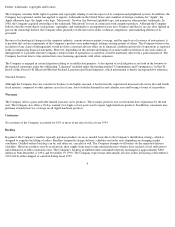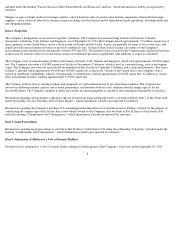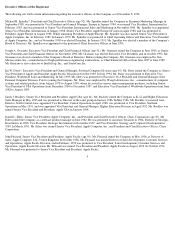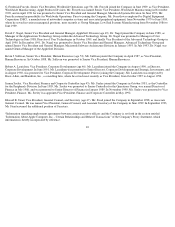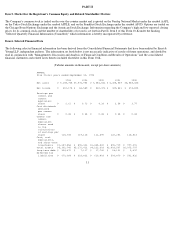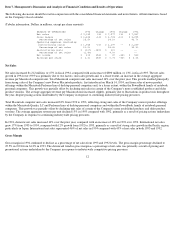Apple 1994 Annual Report Download - page 7
Download and view the complete annual report
Please find page 7 of the 1994 Apple annual report below. You can navigate through the pages in the report by either clicking on the pages listed below, or by using the keyword search tool below to find specific information within the annual report.division and the Apple Pacific division. The Apple Europe division, based in Paris, France, focuses on opportunities in Europe as well as in
parts of Africa and in the Middle East. Products sold by the Europe division are manufactured primarily in the Company's facility in Cork,
Ireland. The Apple Pacific division, based in Cupertino, California, focuses on opportunities in Japan, Australia, Canada, the Far East, and
Latin America. Products sold by the Pacific division are manufactured primarily in the Company's manufacturing and assembly facilities in
California, Colorado and Singapore.
A summary of the Company's Industry Segment and Geographic Information may be found in Part II, Item 8 of this Form 10-K under the
heading "Industry Segment and Geographic Information", which information is hereby incorporated by reference.
Raw materials
Although raw materials, processes, and components essential to the Company's business are generally available from multiple sources, certain
key components are currently obtained from single sources. For example, certain microprocessors used in many of the Company's products are
currently available only from Motorola, Inc. Any availability limitations, interruption in supplies, or price increases relative to these and other
components could adversely affect the Company's business and financial results. Key components and processes currently obtained from single
sources include certain of the Company's displays, microprocessors, mouse devices, keyboards, disk drives, CD-ROM drives, printers and
printer components, ASICs and other custom chips, and certain processes relating to construction of the plastic housing for the Company's
computers. In addition, new products introduced by the Company often initially utilize custom components obtained from only one source,
until the Company has evaluated whether there is a need for an additional supplier. In situations where a component or product utilizes new
technologies and processes, there may be initial capacity constraints until such time as the suppliers' yields have matured. Materials and
components are normally acquired through purchase orders, as is common in the industry, typically covering the Company's requirements for
periods from 90 to 180 days. However, the Company continues to evaluate the need for a supply contract in each situation.
If the supply of a key single-sourced material, process, or component to the Company were to be delayed or curtailed, its ability to ship the
related product utilizing such material, process, or component in desired quantities and in a timely manner could be adversely affected. The
Company's business and financial performance could also be adversely affected, depending on the time required to obtain sufficient quantities
from the original source, or to identify and obtain sufficient quantities from an alternate source. The Company believes that the suppliers whose
loss to the Company could have a material adverse effect upon the Company's business and financial position include, at this time, Canon, Inc.,
General Electric Co., Hitachi, Ltd., IBM, Motorola, Inc., Sharp Corporation, Sony Corporation, Texas Instruments, Inc., Tokyo Electric Co.,
Ltd., and/or their United States affiliates, and VLSI Technology, Inc. However, the Company helps mitigate these potential risks by working
closely with these and other key suppliers on product introduction plans, strategic inventories, and coordinated product introductions. The
Company believes that most of its single-source suppliers, including most of the foregoing companies, are reliable multinational corporations.
Most of these suppliers manufacture the relevant materials, processes, or components in multiple plants. The Company further believes that its
long-standing business relationships with these and other key suppliers are strong and mutually beneficial in nature.
The Company has a supply agreement with Motorola, Inc. (see Exhibit 10.B.12 hereto). The agreement with Motorola continues for five years
from January 31, 1992 unless otherwise mutually agreed in writing by the parties. The Company single-sources microprocessors from
Motorola. The supply agreement does not obligate the Company to make minimum purchase commitments; however, the agreement does
commit the vendor to supply the Company's requirements of the particular items for the duration of the agreement.
The Company has also from time to time experienced significant price increases and limited availability of certain components that are
available from multiple sources, such as dynamic random-access memory devices. Any similar occurrences in the future could have an adverse
effect on the Company's operating results.
5

